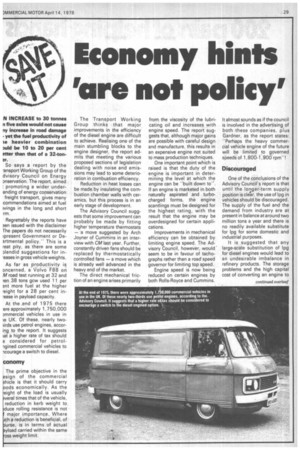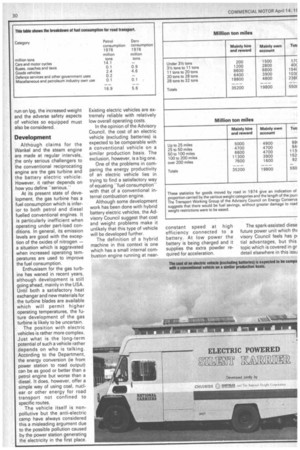Economy hints 'are not policy'
Page 31

Page 32

If you've noticed an error in this article please click here to report it so we can fix it.
N INCREASE to 30 tonnes n five axles would not cause ny increase in road damage yet the fuel productivity of le heavier combination wild be 10 to 20 per cent etter than that of a 32-toner.
So says a report by the -ansport Working Group of the dvisory Council on Energy onservation. The report, aimed promoting a wider underending of energy conservation freight transport, gives many !commendations aimed at fuel ivings in the long and short • rm.
Regrettably the reports have aen issued with the disclaimer The papers do not necessarily ipresent Government or Deartmental policy."' This is a reat pity, as there are some Dlendid suggestions for in'eases in gross vehicle weights.
As far as productivity is oncerned, a Volvo F88 on M road test running at 32 and )en 38 tons gcw used 11 per ant more fuel at the higher 'eight for a 28 per cent in,ease in payload capacity.
At the .end of 1975 there -ere approximately 1,750,000 Dmmercial vehicles in use in ie UK. Of these, nearly twoiirds use petrol engines, accoring to the report. It suggests tat a higher rate of tax should e considered for petrol-igined commercial vehicles to ncourage a switch to diesel.
Conomy
The prime objective in the esign of the commercial 3hicle is that it should carry oods economically. As the eight of the load is usually averal times that of the vehicle, reduction in kerb weight to !duce rolling resistance is not I major importance. Where J ch a reduction is beneficial, of purse, is in terms of actual ayload carried within the same ross weight limit. The Transport Working Group thinks that major improvements in the efficiency of the diesel engine are difficult to achieve. Realising one of the main stumbling blocks to the engine designer, the report admits that meeting the various proposed sections of legislation dealing with noise and emissions may lead to some deterioration in combustion efficiency.
Reduction in heat losses can be made by insulating the combustion chamber walls with ceramics, but this process is in an early stage of development.
The Advisory Council suggests that some improvement can probably be made by fitting higher temperature thermostats — -a move suggested by Arch Joyner of Cummins in an interview with CM last year. Further, constantly driven fans should be replaced by thermostatically controlled fans — a move which is already well advanced in the heavy end of the market.
The direct mechanical friction of an engine arises primarily from the viscosity of the lubricating oil and increases with engine speed. The report suggests that, although major gains are possible with careful design and manufacture, this results in an expensive engine not suited to mass production techniques.
One important point which is raised is that the duty of the engine is important in determining the level at which the engine can be -built down to-. If an engine is marketed in both naturally aspirated and turbocharged forms, the engine scantlings must be designed for the highest rating, with the result that the engine may be overdesigned for certain applications.
Improvements in mechanical efficiency can be obtained by limiting engine speed. The Advisory Council, however, would seem to be in favour of tachographs rather than a road speed governor for limiting top speed.
Engine speed is now being reduced on certain engines by both Rolls-Royce and Cummins.
It almost sounds as if the council is involved in the advertising of both these companies, plus Gardner, as the report states' -Perhaps the heavy commercial vehicle engine of the future will be limited to governed speeds of 1,800-1,900 rpm"!
Discouraged
One of the conclusions of the Advisory Council's report is that until the longer-term supply position is clear, the use of lpg in vehicles should be discouraged. The supply of the fuel and the demand from industry are at present in balance at around two million tons a year and there is no readily available substitute for lpg for some domestic and industrial purposes.
It is suggested that any large-scale substitution of lpg for diesel engines would lead to an undesirable imbalance in refinery products. The storage problems and the high capital cost of converting an engine to run on lpg, the increased weight and the adverse safety aspects of vehicles so equipped must also be considered.
Development
Although claims for the Wankel and the steam engine are made at regular intervals, the only serious challengers to the conventional reciprocating engine are the gas turbine and the battery electric vehicle. However, it rather depends on how you define "serious."
At its present state of development, the gas turbine has a fuel consumption which is inferior to both petrol and diesel fuelled conventional engines. It is particularly inefficient when operating under part-load conditions. In general, its emission levels are good with the exception of the oxides of nitrogen — a situation which is aggravated when increased operating temperatures are used to improve the fuel consumption.
Enthusiasm for the gas turbine has waned in recent years, although development is still going ahead, mainly in the USA. Until both a satisfactory heat exchanger and new materials for the turbine blades are available which will permit higher operating temperatures, the future development of the gas turbine is likely to be uncertain.
The position with electric vehicles is rather more complex. Just what is the long-term potential of such a vehicle rather depends on who is talking. According to the Department, the energy conversion (ie from power station to road output) can be as good or better than a petrol engine but worse than a diesel. It does, however, offer a simple way of using coal, nuclear or other energy for road transport not confined to specific routes.
The vehicle itself is nonpollutive but the anti-electric camp have always considered this a misleading argument due to the possible pollution caused by the power station generating the electricity in the first place. Existing electric vehicles are extremely reliable with relatively low overall operating costs.
In the opinion of the Advisory Council, the cost of an electric vehicle (excluding batteries) is expected to be comparable with a conventional vehicle on a similar production basis. The exclusion, however, is a big one.
One of the problems in comparing the energy productivity of an electric vehicle lies in trying to find a satisfactory way of equating "fuel consumption" with that of a conventional internal combustion engine.
Although some development work has been done with hybrid battery electric vehicles, the Advisory Council suggest that cost and weight problems make it unlikely that this type of vehicle will be developed further.
The definition of a hybrid machine in this context is one which has a small internal combustion .engine running at near constant speed at high efficiency connected to a battery. At low power the battery is being charged and it supplies the extra powder required for acceleration.
The spark-assisted diese future power unit which thi visory Council feels has pi tial advantages, but this topic which is covered in gr detail elsewhere in this issu












































































































